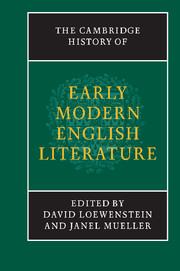Book contents
- Frontmatter
- Introduction
- 1 Modes and means of literary production, circulation and reception
- 2 The Tudor era from the Reformation to Elizabeth I
- 3 The era of Elizabeth and James VI
- 10 Literature and national identity
- 11 Literature and the court
- 12 Literature and the church
- 13 Literature and London
- 14 Literature and the theatre
- 4 The earlier Stuart era
- 5 The Civil War and Commonwealth era
- Chronological outline of historical events and texts in Britain, 1528–1674, with list of selected manuscripts
- Select bibliography (primary and secondary sources)
- Index
- References
12 - Literature and the church
from 3 - The era of Elizabeth and James VI
Published online by Cambridge University Press: 28 March 2008
- Frontmatter
- Introduction
- 1 Modes and means of literary production, circulation and reception
- 2 The Tudor era from the Reformation to Elizabeth I
- 3 The era of Elizabeth and James VI
- 10 Literature and national identity
- 11 Literature and the court
- 12 Literature and the church
- 13 Literature and London
- 14 Literature and the theatre
- 4 The earlier Stuart era
- 5 The Civil War and Commonwealth era
- Chronological outline of historical events and texts in Britain, 1528–1674, with list of selected manuscripts
- Select bibliography (primary and secondary sources)
- Index
- References
Summary
‘Religious literature’ is a category which cannot be measured with statistical precision. What we in a more secular age call ‘religion’, a discrete phenomenon, permeated many areas of early modern life and much of its book production. Broadsheet ballads and pamphlets, precursors of both newspapers and novels, may have entertained, even titillated, but they professed to teach moral lessons. Preachers and journalistic hacks, writers of murder pamphlets and the like, invaded each others’ generic spaces. Popular songs were instantly ‘moralised’, with improving lyrics set to the same tunes. Historians and poets disputed which of their disciplines was in the better position to encourage ‘virtue’. Sir Philip Sidney thought poetry more ‘doctrinable’. ‘Truth’ was at a premium. The Bible was the ultimate in truth, but chronicles, too, were said to ‘carry credit’.
But religious books, by a more exclusive and conventional criterion, will be found to have been the single most important staple of the publishing industry, making up roughly half of its output. This suggests considerable public interest in the subject, although two factors other than piety must be taken into account in explaining the volume of religious publication. On the one hand there were the commercial motives of printers and booksellers (presumably responsive to demand); on the other, the interest of state and church and of organised bodies of religious opinion, often critical, even dissident. These were factors of ‘push’ rather than ‘pull’. Even supposedly ‘popular’ literary forms may have been popular only in the sense that they were products intended by their social and intellectual betters for the improvement of the semi-literate, a process of downward cultural mediation.
- Type
- Chapter
- Information
- The Cambridge History of Early Modern English Literature , pp. 374 - 398Publisher: Cambridge University PressPrint publication year: 2003
References
- 2
- Cited by

